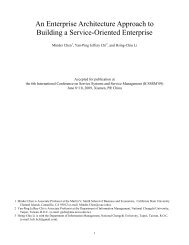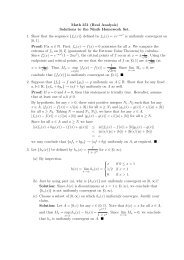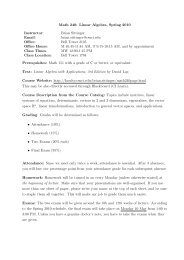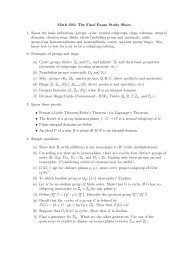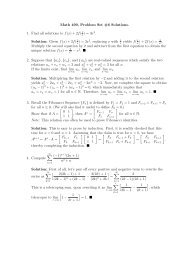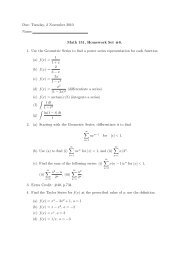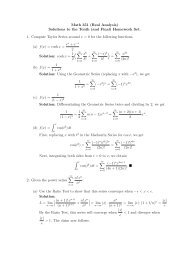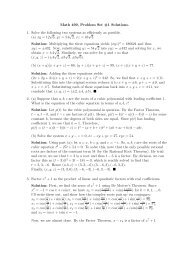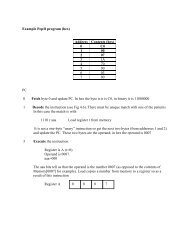GRE Math Subject Test #4 Solutions. 1. B (Calculus/Geometry) This ...
GRE Math Subject Test #4 Solutions. 1. B (Calculus/Geometry) This ...
GRE Math Subject Test #4 Solutions. 1. B (Calculus/Geometry) This ...
Create successful ePaper yourself
Turn your PDF publications into a flip-book with our unique Google optimized e-Paper software.
16. D (<strong>Calculus</strong>) Using the disk method, the volume equals∫ ∞ 1π( √0 1+x 2) 2 ∣dx = π arctan x = π2 . 2∣ ∞ 017. B (Algebra/<strong>Calculus</strong>) Since the polynomial is of odd degree, it has at least one realroot (by the Intermediate Value Theorem). However, since f ′ (x) = 32x 4 + 8 > 0 forall x, we see that f is increasing for all x. Hence, f has exactly one real root.18. A (Linear Algebra) The subspace in question is the null space of T . So theRank-Nullity Theorem implies that it has dimension 6 − 4 = 2.19. C (<strong>Calculus</strong>/Real Analysis) Use Cauchy’s Mean Value Theorem.20. D (Real Analysis) <strong>This</strong> is reminiscent of Dirichlet’s function. For any nonzero x, wecan alternately use a sequence of rational/irrational numbers (via density ofrationals/irrationals) which converges to a given nonzero real numbers. Applying fto these sequences will yield different limits. So, f is discontinuous for all x ≠ 0.However, f is continuous at x = 0, which is most easily demonstrated with theSqueeze Theorem, because |x||x|≤ |f(x)| ≤ for all x ∈ R. Letting x → 0 yields3 2lim x→0 |f(x)| = 0, and thus lim x→0 f(x) = 0.2<strong>1.</strong> C (Number Theory) Note that 2 2 · 3 · 5 ∈ P 12 ∩ P 20 .22. B (Linear Algebra) Note that 0 is not in the set in III; so it is automatically not avector subspace. However, the other two are closed under addition and scalarmultiplication.23. A (<strong>Calculus</strong>) Note that we want y ′ = be bx = 10. Letting (x, y) denote the point ofintersection between the curve and tangent line, we solve the system y = 10x andy = e bx = 10. So, 10x = 10 yields bx = <strong>1.</strong> From here, we find that y = e bx = e 1 = eb band thus b = 10.e24. E (<strong>Calculus</strong>) Note that h(x) = e x+x2 − e x . Now, differentiate. (Alternately, use theproduct rule with the Fund. Theorem of <strong>Calculus</strong>.)25. A (Discrete <strong>Math</strong>) Repeated substitution yieldsa 30 = 31 · 30 · ... · 3 · a 29 28 2 1 = 31·30 · 1 = 15 · 3<strong>1.</strong>226. A (<strong>Calculus</strong>) Set the first partial derivatives f x = 2x − 2y and f y = −2x + 3y 2 equalto 0. In particular, the critical points are on the line y = x.27. D (Linear Algebra) Solve these as a system of linear equations (row reducing viaaugmented matrices may be useful).28. D (Discrete <strong>Math</strong>) Can you see why 1, 2, or 3 are not sufficient?29. C (<strong>Calculus</strong>) Try f(x) = x and g(x) = x + 1 for a quick counterexample.30. C (Logic) Be careful with the quantifiers.



